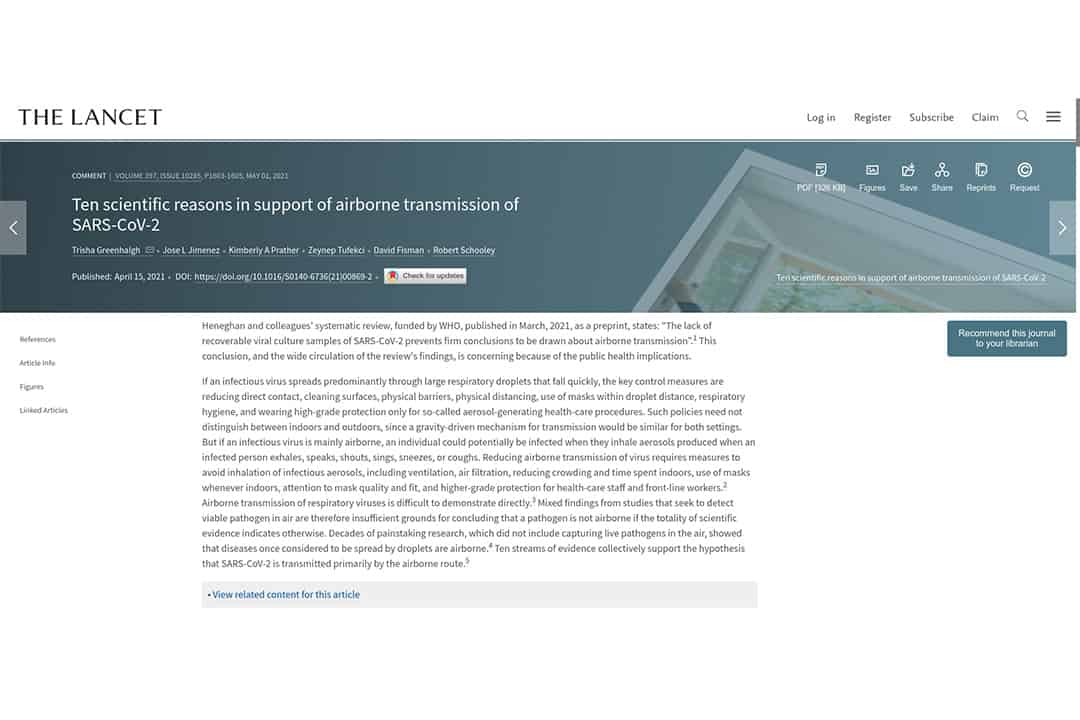When the SARS-CoV-2 virus first spread and led to the COVID-19 pandemic, the World Health Organization (WHO) insisted that it spread mainly by traveling through respiratory droplets, and the WHO made recommendations based on that assumption.
More recently, however, many researchers have argued that SARS-CoV-2 mostly transmits through airborne aerosols, and current research supports their hypothesis. This distinction has a profound impact on what public health measures can limit infection.
Droplets vs. aerosols
Droplets and aerosols primarily differ in their sizes and the distances they can travel. Droplets are larger and tend to travel less than six feet before quickly falling to the ground, rendering them ineffective at transmitting the virus. In contrast, aerosols are smaller and can travel much further. More importantly, they can stay in the air for anywhere from 30 minutes to hours — hence, the term ‘airborne’ — which significantly increases their chances of being inhaled.
Due to their short-range travel, transmission through droplets can be mitigated by limiting physical contact, washing hands regularly, wearing masks, and cleaning all surfaces. On the other hand, controlling airborne transmission requires additional measures to dilute the number of aerosols in the air, such as air ventilation and filtration. Both practices reduce the intensity and duration of exposure.
“[It’s] a multi-layered approach and no layer is perfect,” said Jeffrey Siegel, a professor of civil engineering at U of T, in an interview with The Varsity. Siegel studies indoor air quality and the performance of air filtering and ventilation performance. While he agreed that it’s important for the university to have robust ventilation and filtration systems in classrooms, he noted that they aren’t a magical solution that will contain the spread of the virus.
Resistance from the WHO
The WHO has been hesitant to confirm SARS-CoV-2’s potential for airborne transmission, despite the push from the scientific community. On July 6, 2020, over 200 scientists signed an open letter asking the WHO to take airborne transmission into consideration and revise its health guidelines.
Three days later, the WHO acknowledged the possibility of aerosol transmission in a statement: “Short-range aerosol transmission, particularly in specific indoor locations, such as crowded and inadequately ventilated spaces over a prolonged period of time with infected persons cannot be ruled out.” However, it did not issue any new health guidelines.
There were no further updates until a review funded by the WHO came out as a preprint, before being peer reviewed for publication, in March 2021. In the paper, the authors identified and assessed 89 different studies that tried to detect SARS-CoV-2 aerosols. They found these studies to be “low quality” and claimed that, “The lack of recoverable viral culture samples of SARS-CoV-2 prevents firm conclusions to be drawn about airborne transmission.”
Criticisms from researchers
On April 15, six scientists — including U of T epidemiologist David Fisman — refuted this conclusion in the medical journal Lancet with an article titled, “Ten scientific reasons in support of airborne transmission of SARS-CoV-2.” The researchers dispute the WHO-funded review by citing several instances that demonstrate SARS-CoV-2’s capacity for aerosol transmission.
They mention examples where SARS-CoV-2 aerosols were detected, such as cases where viral matter was recovered in an infected person’s car or in places that could only be reached by aerosols, like air filters and building ducts, and cases transmission among healthcare workers who only had protection against respiratory droplets.
Other evidence illustrates the role of ventilation, including COVID-19’s higher transmission rates indoors compared to outdoors, several superspreading incidents in places with low ventilation, and transmission between individuals who were in adjacent rooms but not in direct contact with each other.
In the end, the authors pointedly state that, “It is a scientific error to use lack of direct evidence of SARS-CoV-2 in some air samples to cast doubt on airborne transmission while overlooking the quality and strength of the overall evidence base,” and that, “The public health community should act accordingly without further delay.”
The WHO finally acknowledged airborne transmission of SARS-CoV-2 on its website on April 30. The organization revised its health guidelines, explicitly stating that ventilation is important in controlling COVID-19 transmission. It advises that, in addition to physical distancing measures, we should also avoid confined and poorly ventilated spaces as much as possible. If not, it recommends airing the room out by opening windows.
Changes in public health guidelines
Except for those in healthcare facilities, air circulation systems are not designed with infection control in mind. As such, researchers recommend that large public spaces such as schools and offices modify their existing systems to enhance ventilation and filtration.
The Canadian government’s website for guidance on COVID-19 advises that institutions should have their buildings evaluated by experts to ensure that ventilation and air conditioning systems meet COVID-19 standards, since different buildings will require individualized changes depending on their setting, number of occupants, the type of activities they host, and the duration of their use.
For spaces that are continuously used, such as classrooms, the guideline advises that individuals should air them out by opening windows for a few minutes, and occupants should have regular outdoor breaks “to limit the potential buildup of potentially infectious respiratory droplets or particles over time.”
As the university opens its doors to in-person classes this fall, U of T has announced a 12-part approach to protecting students, faculty, and staff, and ensuring a safe environment on campus, including upgrading air ventilation systems as part of the COVID-19 heating, ventilation, and air conditioning (HVAC) strategy.
“I would describe [U of T’s reopening strategy] as a really good aspirational plan,” said Siegel. He is concerned, however, about whether the university will actually reach the targets that it has set out. For instance, the filters that the university is upgrading to might not perform as well as they do in lab conditions when they are put to use in classroom ventilators.
— With files from Khatchig Anteblian


